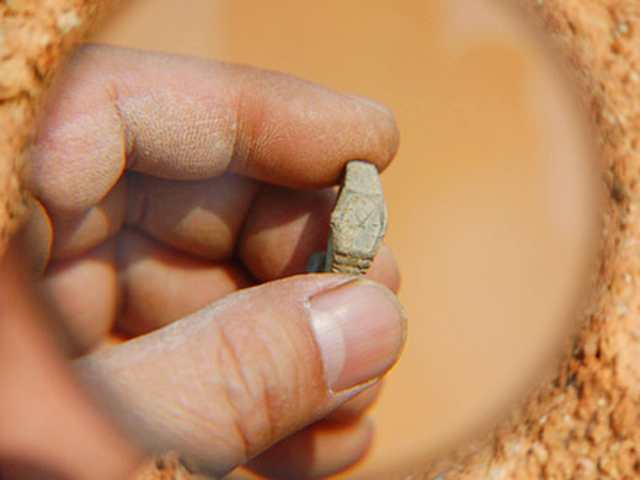The Unveiling of a Swiss Watch’s Journey Through Ming Dynasty Mysteries
Unraveling the Enigma of a Swiss Watch in a 400-Year-Old Chinese Tomb: While some enigmas find resolution, the allure of many mysteries persists, forever shrouded in the elusive veil of the unknown. A recent baffling revelation adds another layer to this age-old intrigue—an antique Swiss watch discovered in an ancient Chinese tomb, its secrets concealed for over four centuries. The tomb, located in Shangsi, southern China, had remained sealed since the Ming Dynasty (15-16th centuries), heightening the bewilderment surrounding the timepiece’s origin and purpose.
The miniature watch, cleverly designed in the form of a ring, appears to be a relic of the last century. Encrusted in a mixture of mud and rock, frozen in time at 10:06 am, the watch bears the intriguing engraving ‘Swiss’ on its back. This unexpected find raises a cascade of questions, compelling archaeologists to ponder: How did this distinctly modern Swiss timepiece find its way into an ancient tomb untouched for centuries? Was it intentionally placed there, and if so, by whom and for what purpose?
The available facts only deepen the enigma. While the Ming Dynasty did witness its own era of watchmaking, the presence of the English word ‘Swiss’ on the back of the watch defies easy explanation. Geneva, Switzerland, where the renowned watchmaking tradition thrived, predominantly used French and German languages during this period. Furthermore, historical records indicate a ban on ostentatious jewelry in Geneva in 1541, suggesting the practicality of a watch ring. However, the absence of any evidence supporting the popularity of ring watches in Europe until after 1780 adds another layer of complexity to the mystery.
The discovery unfolded during the filming of a documentary, catching archaeologists off guard with its perplexing nature. The dig has been temporarily halted, awaiting the expertise of specialists from Beijing who may help unravel the intricacies of this unsettling puzzle.
As questions continue to swirl around this time-traveling timepiece, its silent presence in the ancient tomb echoes the unresolved mysteries of the past. The enigma of the Swiss watch in the Ming Dynasty tomb persists, inviting speculation and sparking the imagination—a testament to the enduring allure of historical puzzles that beckon us to decipher their secrets.
Ming Dynasty
The Ming Dynasty stands as a monumental chapter in the rich tapestry of Chinese history, weaving together the cultural, political, and social threads that defined an era. Established by the Han people under the visionary leadership of the Hongwu Emperor, the Ming Dynasty emerged from the ashes of the Yuan Dynasty, signaling a return to native rule. Hongwu’s reign marked a departure from the Mongol influences, and his Huang-Ming Zuxun, or the Instructions for the Successor, became a cornerstone for governance, emphasizing the importance of agricultural prosperity, frugality, and the well-being of the common people.
However, the Ming Dynasty’s journey was not without internal strife and power struggles. The succession crisis following the death of the Jianwen Emperor led to the ascension of the Yongle Emperor, whose military prowess and ambitious expeditions established the Ming as a dominant force in Asia. The construction of the Forbidden City and the voyages of Zheng He epitomized the Yongle Emperor’s grand vision, solidifying the Ming Dynasty’s influence beyond its borders.
Yet, the Ming Dynasty experienced its share of challenges. The rebellion led by Li Zicheng, a peasant leader, culminated in the fall of the Ming imperial family and the establishment of the Shun dynasty. This marked a tumultuous period that shook the foundations of Ming rule, reflecting the complex interplay of socio-economic factors and political unrest.
Yingzong of Ming, who reigned during this turbulent time, faced the arduous task of restoring stability. His efforts to reclaim power showcased the resilience of the Ming Dynasty, illustrating the deep-seated connection between rulers and their subjects. The Ming imperial family, through triumphs and tribulations, remained central to the narrative of China’s past, embodying the intricate balance of tradition and adaptation.
The Ming Dynasty’s legacy extended beyond political maneuvering; it fostered a cultural renaissance that left an indelible mark on Chinese civilization. Art, literature, and philosophy flourished during this period, with notable contributions such as the iconic blue-and-white porcelain and the epic novel “Journey to the West” capturing the imagination of generations. Ming scholars embraced Confucian ideals, emphasizing virtue, filial piety, and ethical governance, shaping the intellectual landscape of the time.
The enduring allure of the Ming Dynasty lies not only in its grandeur and accomplishments but also in its moments of vulnerability and introspection. The ebb and flow of power, the intricate dance between rulers and rebels, all add layers of complexity to this historical narrative. As we delve into the heart of the Ming Dynasty, we encounter a civilization at the crossroads, navigating the currents of change with resilience and ingenuity.
In essence, the Ming Dynasty serves as a captivating tableau of China‘s past—a testament to the tenacity of the Han people, the dynamism of imperial rule, and the intricate interplay of historical forces. Whether examining the grand architecture of the Forbidden City or contemplating the philosophical musings of Ming scholars, the legacy of this dynasty resonates as a living testament to a bygone era that continues to shape the contours of contemporary China.

